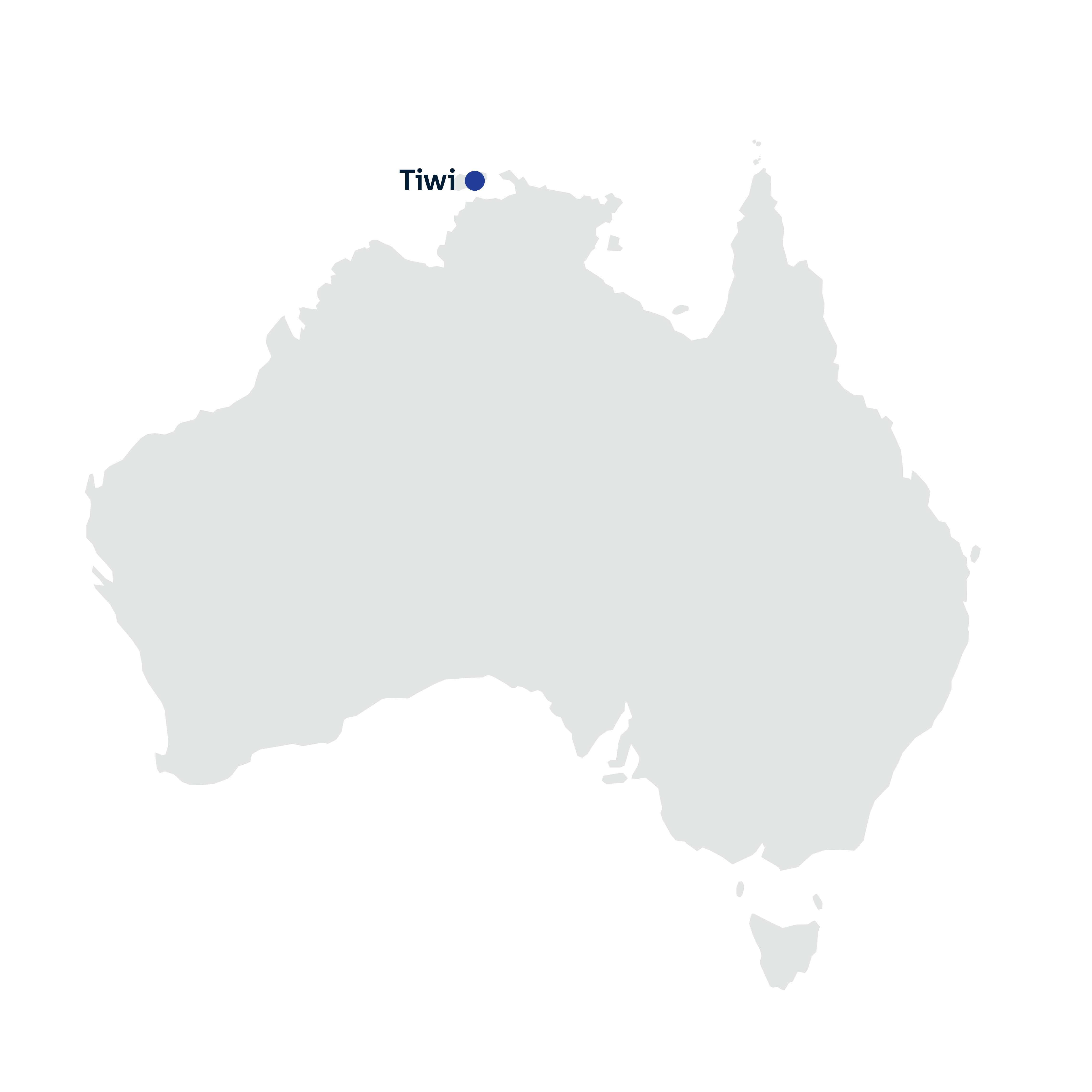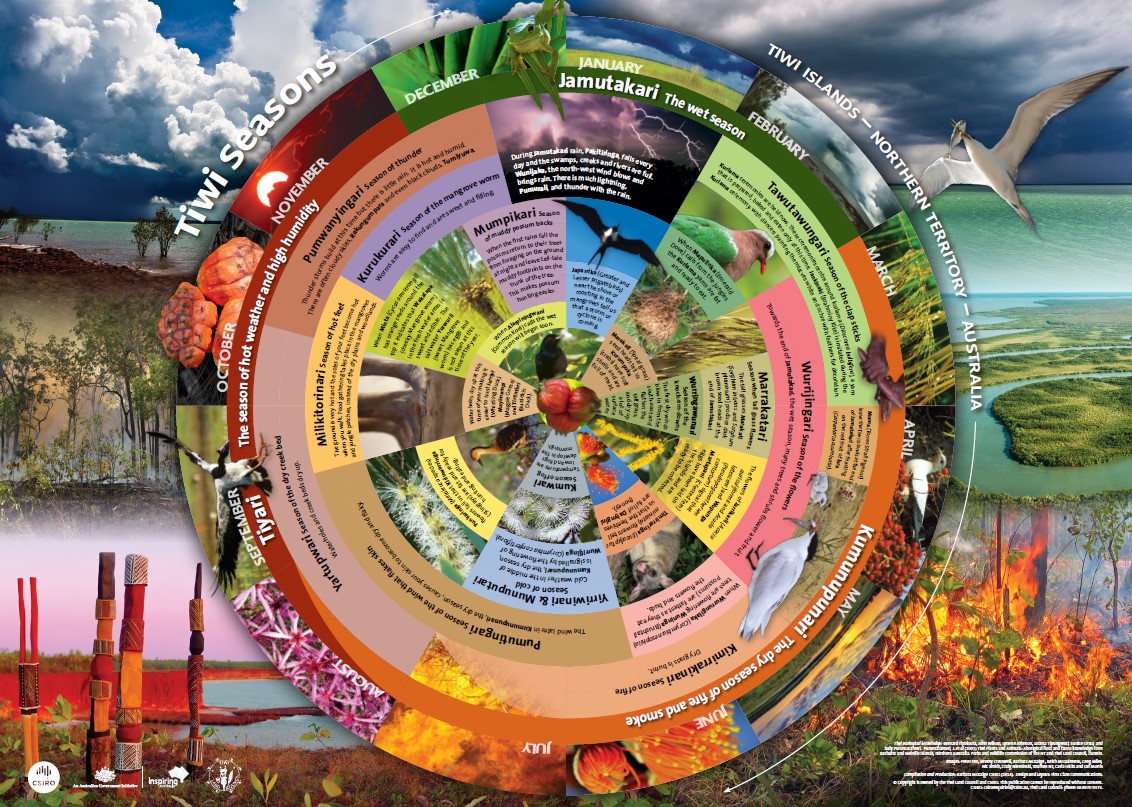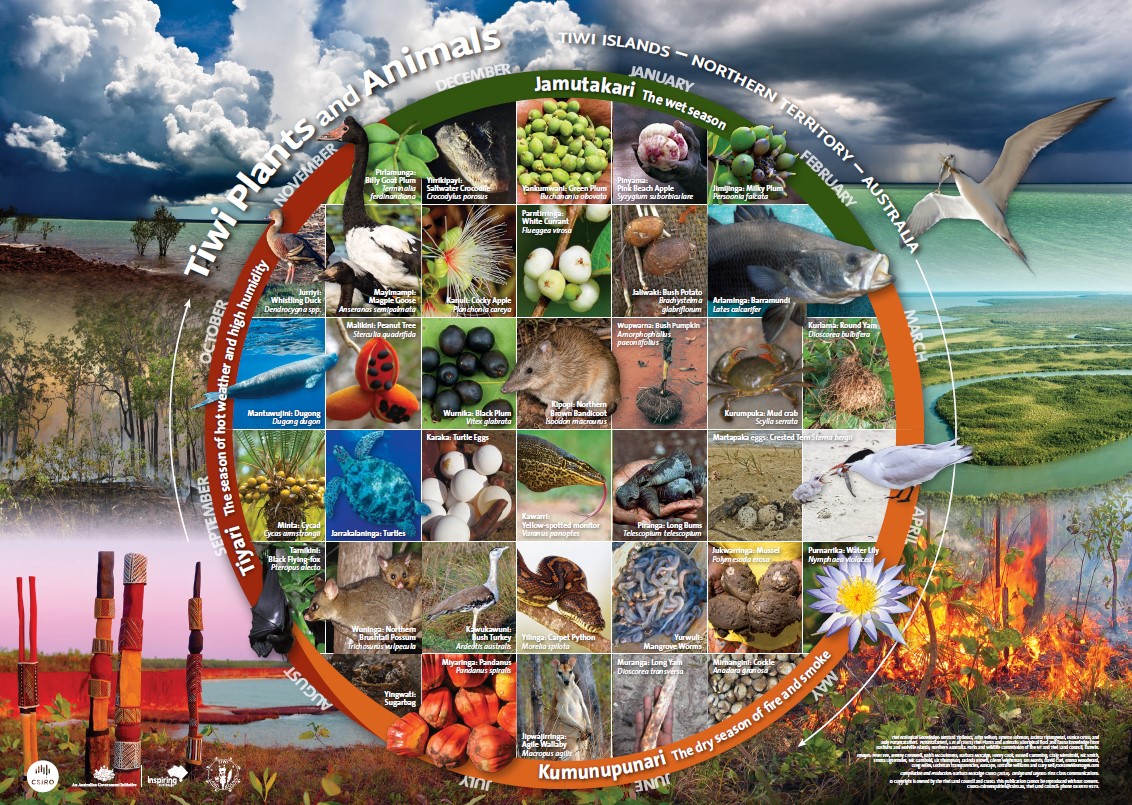 Traditional Owners from the Tiwi Islands and the Tiwi Land Council collaborated with CSIRO to develop two calendars:
Traditional Owners from the Tiwi Islands and the Tiwi Land Council collaborated with CSIRO to develop two calendars:
- a calendar of Tiwi seasonal ecological knowledge; and
- a calendar of plants and animals of Tiwi significance.
The development of the calendars came from a desire to document seasonal-specific knowledge and ecological knowledge of the Tiwi Islands in an appealing format accessible to both students and the broader community, as well as a strong concern about the loss of knowledge as older people pass away.
Senior Tiwi Traditional Owner, Bernard Tipiloura said there has been a significant loss of knowledge over the past 10 to 15 years on the Tiwi Islands.
“We’re worried that kids are not learning culture so we need to think of new ways to teach them and these calendars will make a huge difference,” he said.
“I feel very good about the Tiwi Seasons calendar and the Tiwi Plants and Animals calendar. The more of these things we can do, the better it will be for Tiwi culture. We need to educate the children so they can take over from us when we’re gone.”
Tiwi seasons calendar

The three major Tiwi seasons are:
- Kumunupunari – (March to August) is the dry season of fire and smoke.
- Tiyari – (September to November) is the season of hot weather and high humidity.
- Jamutakari – (December to February) is the wet season when pakitiringa (rain) falls consistently every day and the swamps, creeks and rivers are full. Wunijaka, the north-west wind blows and brings rain. There is much pumurali (lightning) and thunder with the rain.
The thirteen minor overlapping Tiwi seasons are:
- Wurringawunari – Season of the knock-em-downs. This is the first part of the dry season when the first dry winds blow in from the south-east, flattening the tall grass and drying up surface water.
- Kimirrakinari – Season of fire when dry grass is burnt.
- Pumutingari – Season of the wind that flakes skin.
- Yirriwinari and Mirniputari – Season of cold weather in the middle of the dry season, mid-June to the end of July, is signalled by the flowering of Wurritjinga (Eucalyptus confertiflora)
- Kumwari – Season of fog, when temperatures are low and fog develops in the mornings.
- Yartupwari – Season of the dry creek bed, when waterholes and creek beds dry up.
- Milikitorinari – Season of hot feet, when the hot ground burns the soles of feet. Food gathering is concentrated in the mangroves and jungle patches instead of the dry plains and woodlands.
- Pumwanyingar – Season of thunder. Humidity increases and clouds develop every afternoon but there is little rain.
- Kurukurari – Season of the mangrove worm. The worms are easy to find and are sweet and filling.
- Mumpikari – Season of muddy possum tracks. When the first rains fall the possums return to their trees from foraging on the ground at night and leave tell-tale muddy footprints on the trunk of the tree. This makes possum hunting easier.
- Tawutawungari – Season of the clap sticks. Kurlama (special yam) ceremonies are held now.
- Wurrijingari – Season of the flowers.
- Marrakatari – Season when tall grass flowers, and Wurringawunari - Season of the knock-em-downs, are both short and indicate the end of the wet season.
The Tiwi seasons calendar was produced as part of an Inspiring Australia Unlocking Australia’s Potential grant. 1
Tiwi plants and animals calendar

Plants and animals of Tiwi significance by season
Jamutakari (The wet season)
- Yankumwani – Green plum (Buchanania obovata)
- Pinyama – Pink bush apple (Syzygium suborbiculare)
- Jaliwaki – Bush potato (Brachystelma glabriflorum)
- Wuninga – Northern brushtail possum (Trichosurus vulpecular)
- Yirrikipayi – Saltwater crocodile (Crocodylus porosus)
- Arlaminga – Barramundi (Lates calcarifer)
- Martapani – Crested tern - (Thalasseus bergii) eggs
- Kamuli – Cocky apple (Planchonia careya)
Kumunpunari (The dry season of fire and smoke)
- Kurlama – Yam (Dioscorea bulbifera)
- Purnarrika – Water lily (Nymphaea violacea)
- Wupwarna – Bush pumpkin (Amorphophallus paeoniifolius)
- Muranga – Long yam (Dioscorea transversa)
- Jukwarringa – Mud mussel (Polymesoda erosa)
- Kawukawuni – Bush turkey (Ardeotis australis)
- Yilinga – Carpet python (Morelia spilota)
- Jarrakalaninga – Turtles
Tiyari (The season of hot weather and high humidity)
- Minta – Cycad (Cycas armstrongii)
- Malinki – Peanut tree (Sterculia quadrifida)
- Mayimampi – Magpie geese (Anseranas semipalmata)
- Mantuwunjini – Dugong (Dugong dugon)
- Jurriyi – Whistling duck (Dendrocygna spp.)
- Yurwuli – Mangrove worms
The Tiwi plants and animals calendar was produced as part of an Inspiring Australia Unlocking Australia’s Potential grant. 2
Citation
- Tipiloura B, Wilson J, Johnson L, Tipungwuti J, Orsto E, Puruntatameri J and McKaige B. 2014. Tiwi Seasons, Tiwi Islands, Northern Territory, Australia. CSIRO Land and Water.
- Tipiloura B, Wilson J, Johnson L, Tipungwuti J, Orsto E, Puruntatameri J and McKaige B. 2014. Tiwi Plants and Animals, Tiwi Islands, Northern Territory, Australia. CSIRO Land and Water.
Traditional Owners from the Tiwi Islands and the Tiwi Land Council collaborated with CSIRO to develop two calendars:
- a calendar of Tiwi seasonal ecological knowledge; and
- a calendar of plants and animals of Tiwi significance.
The development of the calendars came from a desire to document seasonal-specific knowledge and ecological knowledge of the Tiwi Islands in an appealing format accessible to both students and the broader community, as well as a strong concern about the loss of knowledge as older people pass away.
Senior Tiwi Traditional Owner, Bernard Tipiloura said there has been a significant loss of knowledge over the past 10 to 15 years on the Tiwi Islands.
“We’re worried that kids are not learning culture so we need to think of new ways to teach them and these calendars will make a huge difference,” he said.
“I feel very good about the Tiwi Seasons calendar and the Tiwi Plants and Animals calendar. The more of these things we can do, the better it will be for Tiwi culture. We need to educate the children so they can take over from us when we’re gone.”
Tiwi seasons calendar
The three major Tiwi seasons are:
- Kumunupunari – (March to August) is the dry season of fire and smoke.
- Tiyari – (September to November) is the season of hot weather and high humidity.
- Jamutakari – (December to February) is the wet season when pakitiringa (rain) falls consistently every day and the swamps, creeks and rivers are full. Wunijaka, the north-west wind blows and brings rain. There is much pumurali (lightning) and thunder with the rain.
The thirteen minor overlapping Tiwi seasons are:
- Wurringawunari – Season of the knock-em-downs. This is the first part of the dry season when the first dry winds blow in from the south-east, flattening the tall grass and drying up surface water.
- Kimirrakinari – Season of fire when dry grass is burnt.
- Pumutingari – Season of the wind that flakes skin.
- Yirriwinari and Mirniputari – Season of cold weather in the middle of the dry season, mid-June to the end of July, is signalled by the flowering of Wurritjinga (Eucalyptus confertiflora)
- Kumwari – Season of fog, when temperatures are low and fog develops in the mornings.
- Yartupwari – Season of the dry creek bed, when waterholes and creek beds dry up.
- Milikitorinari – Season of hot feet, when the hot ground burns the soles of feet. Food gathering is concentrated in the mangroves and jungle patches instead of the dry plains and woodlands.
- Pumwanyingar – Season of thunder. Humidity increases and clouds develop every afternoon but there is little rain.
- Kurukurari – Season of the mangrove worm. The worms are easy to find and are sweet and filling.
- Mumpikari – Season of muddy possum tracks. When the first rains fall the possums return to their trees from foraging on the ground at night and leave tell-tale muddy footprints on the trunk of the tree. This makes possum hunting easier.
- Tawutawungari – Season of the clap sticks. Kurlama (special yam) ceremonies are held now.
- Wurrijingari – Season of the flowers.
- Marrakatari – Season when tall grass flowers, and Wurringawunari - Season of the knock-em-downs, are both short and indicate the end of the wet season.
The Tiwi seasons calendar was produced as part of an Inspiring Australia Unlocking Australia’s Potential grant. 1
Tiwi plants and animals calendar
Plants and animals of Tiwi significance by season
Jamutakari (The wet season)
- Yankumwani – Green plum (Buchanania obovata)
- Pinyama – Pink bush apple (Syzygium suborbiculare)
- Jaliwaki – Bush potato (Brachystelma glabriflorum)
- Wuninga – Northern brushtail possum (Trichosurus vulpecular)
- Yirrikipayi – Saltwater crocodile (Crocodylus porosus)
- Arlaminga – Barramundi (Lates calcarifer)
- Martapani – Crested tern - (Thalasseus bergii) eggs
- Kamuli – Cocky apple (Planchonia careya)
Kumunpunari (The dry season of fire and smoke)
- Kurlama – Yam (Dioscorea bulbifera)
- Purnarrika – Water lily (Nymphaea violacea)
- Wupwarna – Bush pumpkin (Amorphophallus paeoniifolius)
- Muranga – Long yam (Dioscorea transversa)
- Jukwarringa – Mud mussel (Polymesoda erosa)
- Kawukawuni – Bush turkey (Ardeotis australis)
- Yilinga – Carpet python (Morelia spilota)
- Jarrakalaninga – Turtles
Tiyari (The season of hot weather and high humidity)
- Minta – Cycad (Cycas armstrongii)
- Malinki – Peanut tree (Sterculia quadrifida)
- Mayimampi – Magpie geese (Anseranas semipalmata)
- Mantuwunjini – Dugong (Dugong dugon)
- Jurriyi – Whistling duck (Dendrocygna spp.)
- Yurwuli – Mangrove worms
The Tiwi plants and animals calendar was produced as part of an Inspiring Australia Unlocking Australia’s Potential grant. 2
Citation
- Tipiloura B, Wilson J, Johnson L, Tipungwuti J, Orsto E, Puruntatameri J and McKaige B. 2014. Tiwi Seasons, Tiwi Islands, Northern Territory, Australia. CSIRO Land and Water.
- Tipiloura B, Wilson J, Johnson L, Tipungwuti J, Orsto E, Puruntatameri J and McKaige B. 2014. Tiwi Plants and Animals, Tiwi Islands, Northern Territory, Australia. CSIRO Land and Water.
